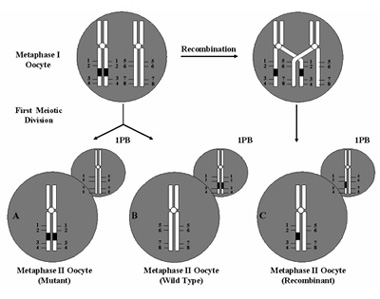Because 1PB contains a genotype opposite to that of its corresponding oocyte, it may be removed before fertilization, and tested to assess the genetic status of the oocyte.
In women who are carriers for a genetic disease, genetic analysis of 1PB allows the identification of oocytes that contain the maternal unaffected gene. In fact, if the 1PB analysis reveals the presence of the maternal mutation, as a consequence both copies of the mutated gene have been extruded and the oocyte can be predicted to be free of mutation. Conversely, if the 1PB does not show any mutation, the oocyte presumptively contains the mutant allele (Figure 1). Only those oocytes diagnosed to contain the normal gene will be fertilized and transferred to the mother without risk of establishing a pregnancy affected by the genetic disease.
Genetic analysis of 1PB may be complicated by recombination events which occur regularly between homologous chromosomes. If crossing-over involves the region containing the gene under investigation, both the mutated and the normal allele segregate to the 1PB while the oocyte retains one copy of both the normal and the mutated gene (Figure 1C).
 Figure 1. First polar bodies (1PBs) (smaller circles) are extruded during maturation of oocytes, after the first meiotic division. Because 1PB is the mirror image of the oocyte, the genotype of the latter can be indirectly derived from the opposite diagnosis of its 1PB. If 1PB analysis does not show any mutation (A), the oocyte presumptively contains the mutant allele. Conversely, if 1PB analysis reveals the presence of the maternal mutation (B), as a consequence both copies of the mutated gene have been extruded and the oocyte can be predicted to be free of mutation.
Figure 1. First polar bodies (1PBs) (smaller circles) are extruded during maturation of oocytes, after the first meiotic division. Because 1PB is the mirror image of the oocyte, the genotype of the latter can be indirectly derived from the opposite diagnosis of its 1PB. If 1PB analysis does not show any mutation (A), the oocyte presumptively contains the mutant allele. Conversely, if 1PB analysis reveals the presence of the maternal mutation (B), as a consequence both copies of the mutated gene have been extruded and the oocyte can be predicted to be free of mutation.
First polar body diagnosis may be complicated by recombination events. If a recombination occurs, involving the region containing the gene under investigation, both the mutated and the normal allele segregate to the 1PB while the oocyte retains one copy of both the normal and the mutated gene (C). In this case, 2PB testing or analysis of the resulting embryos is necessary to predicted genetic status of the oocyte.
The black/filled rectangle represents the gene with maternal mutation. Numbers in bold represent alleles of polymorphic STR markers linked to the gene. 1-2-3-4 is the haplotype associated with the maternal mutation; 5-6-7-8 is the haplotype associated with the normal gene. If crossing over does occur, the 1PB will contain both the normal and the mutated haplotype, showing a heterozygous genotype for the STR markers investigated. (1-5; 2-6; 3-7; 4-8).